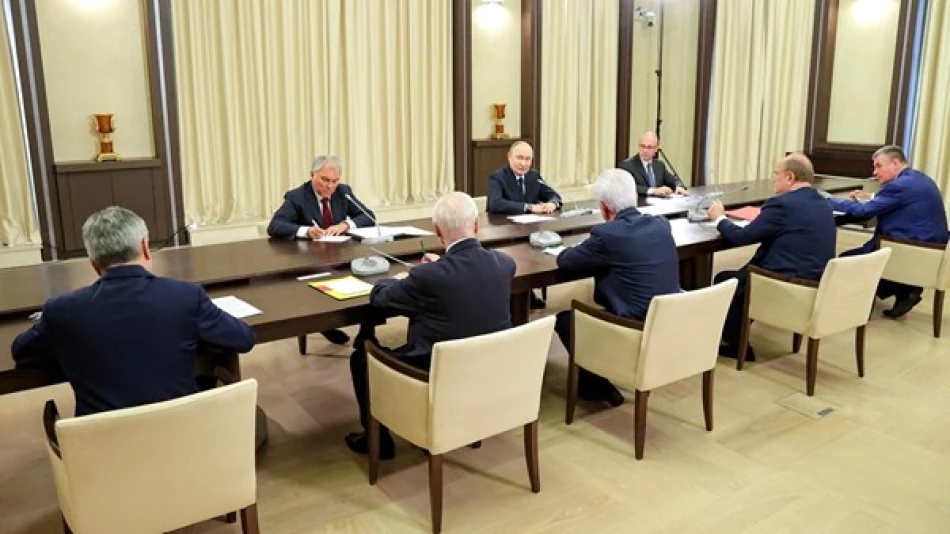
Putin Discloses Russian Troop Numbers on Ukrainian Frontlines
Putin Claims 700,000 Russian Troops Now Fighting in Ukraine as War Enters Fourth Year
Russian President Vladimir Putin has disclosed that over 700,000 Russian soldiers are currently deployed on Ukrainian battlefields, marking the most specific troop figure released by the Kremlin since the conflict began in February 2022. The revelation, made during a parliamentary meeting focused on veteran employment programs, offers rare insight into the massive scale of Russia's military commitment as the war approaches its fourth year.
Unprecedented Military Mobilization Revealed
Putin's statement, delivered to parliamentary leaders in Moscow, represents a significant acknowledgment of Russia's extensive military deployment. "You see, there are more than 700,000 people on the front line," Putin told the assembled officials during discussions about creating employment quotas for war veterans in the post-conflict period.
The figure suggests that more than half of Russia's estimated 1.3 million total armed forces are now engaged in Ukrainian operations, indicating a level of military commitment that exceeds many Western intelligence estimates from earlier phases of the conflict.
Strategic Implications of Massive Deployment
Military Resource Allocation
The 700,000 figure reveals the extent to which Russia has transformed from conducting a "special military operation" to sustaining a large-scale conventional war. This deployment level approaches the size of entire national armies and represents one of the largest sustained military operations in Europe since World War II.
Military analysts have long estimated Russia's total armed forces at approximately 1.3 million personnel, meaning the Ukrainian deployment now accounts for roughly 54% of the country's entire military capacity. This concentration leaves Russia with limited strategic reserves for other potential theaters or domestic security operations.
Comparative Military Scales
Ukraine's active military forces are estimated at around 900,000 troops, creating a numerical advantage for Russian forces of nearly 1.3 to 1. However, this ratio doesn't account for territorial defense forces, international military aid, or the defensive advantages typically required for successful offensive operations.
The scale dwarfs recent conflicts: the U.S. peak deployment in Iraq reached approximately 170,000 troops, while Soviet forces in Afghanistan numbered around 115,000 at their height. Putin's disclosed numbers suggest a conflict intensity more comparable to major 20th-century wars than modern limited interventions.
Economic and Political Ramifications
Labor Market Disruption
The massive military deployment creates significant economic challenges for Russia's domestic labor market. With 700,000 primarily working-age men removed from the civilian economy, sectors from agriculture to manufacturing face acute personnel shortages. Putin's focus on veteran employment programs suggests official recognition that this demographic will require structured reintegration support.
Sustainability Questions
Maintaining such a large force projection requires enormous logistical and financial resources. Defense spending now consumes an estimated 6-7% of Russia's GDP, levels not seen since the Soviet era. The sustainability of this commitment depends heavily on Russia's ability to maintain weapons production, recruit replacements, and finance extended operations despite international sanctions.
Information Warfare and Transparency
Putin's disclosure marks a departure from both sides' typical secrecy regarding troop numbers and casualties. Neither Russia nor Ukraine has provided detailed loss figures, making independent assessment of the conflict's human cost extremely difficult.
The timing of this revelation, during discussions about veteran services, suggests Russia is beginning to plan for large-scale demobilization scenarios. This could indicate either confidence in achieving military objectives or recognition that the current deployment levels are unsustainable long-term.
Regional Security Balance
The confirmed deployment of such massive forces fundamentally alters European security calculations. NATO members, particularly those bordering Russia, must now plan for scenarios where Russia's remaining military capacity is significantly reduced but potentially more concentrated.
For Ukraine's allies, the numbers underscore the scale of support required to maintain defensive capabilities against such overwhelming numerical odds. The disclosure may intensify Western discussions about long-term military aid commitments and strategic planning for various conflict resolution scenarios.
Most Viewed News

 Layla Al Mansoori
Layla Al Mansoori






